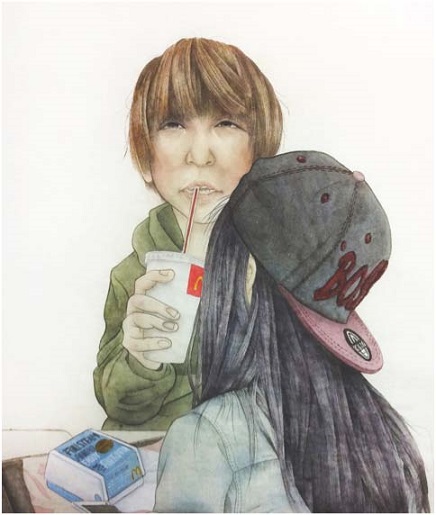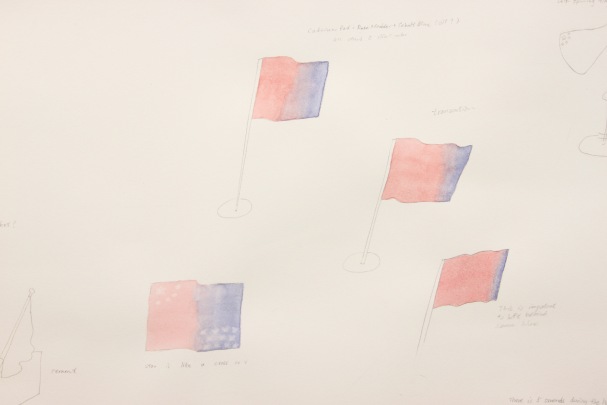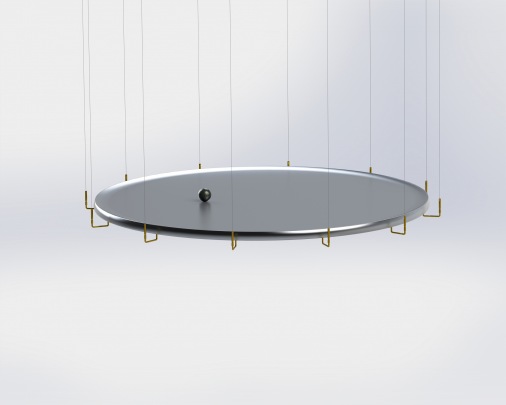藝評
The Future, Like History (an exhibition of 19 Hong Kong artists)
約翰百德 (John BATTEN)
at 2:02pm on 24th November 2015



Captions:
1. Dabie Chiu Yin Man, detail from McRefugees, ink on paper, 2015.
2. Halley Cheng, How do you make an artwork by a flag?, pencil, alcoholic markers, fabric, acrylic on linen, 2015.
3. Homan Ho, Gravity, mixed-media, 2015.
(原文以英文發表,評論〈回到未來〉展。)
“…I want the future now
I'm young, and it's my right.
I want a reason to be proud.
I want to see the light.
I want the future now,
I want to see it on the screen,
I want to break the bounds:
make life worth more than dreams.”
– Peter Hammill, The Future Now (1978)
The future, as the maxim reminds us, always beckons. The future and all its unknowns also prompt speculation. There is an almost-inevitable lineal approach to how we consider the future. This can be seen in the fictional theories and anticipation of future technology in the world of science fiction; this genre’s approach is more akin to the soothsayer’s art of prediction. It can all be highly entertaining – and, like any fiction, not entirely unreal. Uncannily, much is precisely right. The future repeats itself, just like history.
Creativity always plays with the future. Books, films, visual art, music – all creativity – looks back to the future. The reader consciously knows any book is not of the present: it was written, it’s not about to be written. But, the future is rooted in the words of all written fiction, words to be read at a time in the future. That is both a conundrum and the briefest of explanations of this Back to the Future exhibition. We not only look to the future, we look back: back to the future. Such a nonsense notion is allowed in the creative world. We all know Aldous Huxley’s Brave New World, George Orwell’s 1984, and Stanley Kubrick’s 2001: A Space Odyssey, but it is Doris Lessing’s dystopian The Memoirs of a Survivor – with its candid shifts between past, present and future – that gives the essential, cautionary, vision of a – possibly our – future.
We all want the future now; it is the root reason for our dreams. And to dream is to be unconsciously optimistic.
This exhibition has little directly in common with the film of the same name, except significantly the date of 21 October 2015 – the ‘Back to the Future Day’ – coinciding with Hong Kong’s Chung Yeung Festival: a day of grave-cleaning and offerings of food by families who trek to Hong Kong’s far-flung cemeteries to remember their recently passed loved ones and distant ancestors. There is nothing more instructive than the reminder of death or turmoil to judge your future and readjust a life. It is the ‘dark’ offering a brighter future.
Exactly one year ago Hong Kong was a city in the midst of its biggest public dissent since riots spilled across its borders from a Cultural Revolutionary mainland in 1967. Hong Kong’s Umbrella protests called for the city to have greater democracy and protection from an erosion of its “core values”- namely: the rule of law, press freedom and the intolerance of corruption.*
Now, a year later, for many in Hong Kong that are wealthy or with business links with the mainland or – ironically – just fearful of the unknown, the Umbrella protests is an event that now cannot be discussed or referred to, certainly not openly. This avoidance of discussion and reevaluating the issues around the Umbrella protests is reflected in some of the city’s socialite magazines that have assiduously steered away from the topic. It is supposed that their luxury brand advertisers or readership would be opposed to such discussion. This is self-censorship - a reviled action in a liberal society.
However, the Umbrella protests and the concerns for Hong Kong’s future political and social development continue to be well-aired in newspapers, radio, internet forums, at university campuses, on the floor of the Legislative Council and by mainland officials asserting the sovereignty of the People’s Republic of China in Hong Kong. Vigorous debate and commentary always ensues on each occasion that democracy, freedom of expression or the rising influence of the mainland’s Liaison Office is publicly discussed.
Such discussion always revolves around the future. And this is the background to this group exhibition.
Post-Umbrella, Hong Kong’s art scene and galleries have generally continued to discuss ‘sensitive’ issues. Each of the participating artists in Back to the Future has social and political concerns and these are subtly exhibited in this varied exhibition. The majority of participants are recent or near-recent graduates. They are young and reflect Hong Kong’s social environment. They are also ‘promising’ and have the necessary attributes for success, for ‘their future’: ideas, an aesthetic sense, drive and technical skill. But, it is a commitment to all our futures that is their best characteristic.
As the future (no, not the past!) will play tricks on our memory, I offer a brief one-liner (as the mind works, in no particular order) for you to recall each artist:
. Bosco Law: Intricate pointillist drawings (“free will” and “individuality”)
. Ling Pui Sze: Collaged, digital, ink paintings (the mainland’s “biased history”)
. Dabie Chiu: Socially concerned ink paintings of alienation (late night McRefugees)
. Esther Poon: “Yarn bombing” in the city’s streets (knitter.esther)
. Homan Ho: Moving graphite ball (“Ultimately, are we being what we want to be?”)
. Kwong Man Chun: Paintings (of Hong Kong’s “modern and traditional elements”)
. Celia Ko: Jewellery (retro and reconstituted)
. Joyce Lung: Identifying with Hong Kong’s domestic helpers (ceramics)
. Tony Ng: Composed photographs of concrete junk as urban landscapes (dioramas)
. Queenie Kwan: Ink (the “hand, foot and mouth disease” of overused smartphones)
. Sim Chan: Looking upwards (Hong Kong’s trams in the sky)
. Stanley Siu: Architect (with a ‘sweet’ model of the former Hong Kong & Shanghai Bank)
. Vanessa Wong: New maps (not really colonial; see the composite breasts, eyes etc)
. Angela Yuen: Toys as art (important: look at the projected shadows)
. Cam Wong: Etchings (“existence and disappearance”)
. Damon Tong: Stickers (of course, with “spatial connections between image and text”)
. Halley Cheng: A ‘remodelled’ Chinese flag (joining the city’s many “patriotic” flags)
. Local Studio Hong Kong: More maps and slogans (inspired by Hong Kong design)
We go onwards from the past through to the future – and then back again.
Welcome to Back to the Future.
*For further Umbrella explanations, see John Batten, ‘Then.Now’, in South Ho Siu Nam’s good day good night photo-book, Hong Kong, 2015.
Link for further information:
'Back to the Future' exhibition @ Cat Street Gallery
Listen to Peter Hammill, 'The Future Now' from his 1978 album of the same name
This article was originally published in the catalogue which accompanies the 'Back to the Future' group exhibition, Cat Street Gallery, December 2015.
原文刊於Cat Street Gallery之〈回到未來〉展覽場刊,2015年12月。
